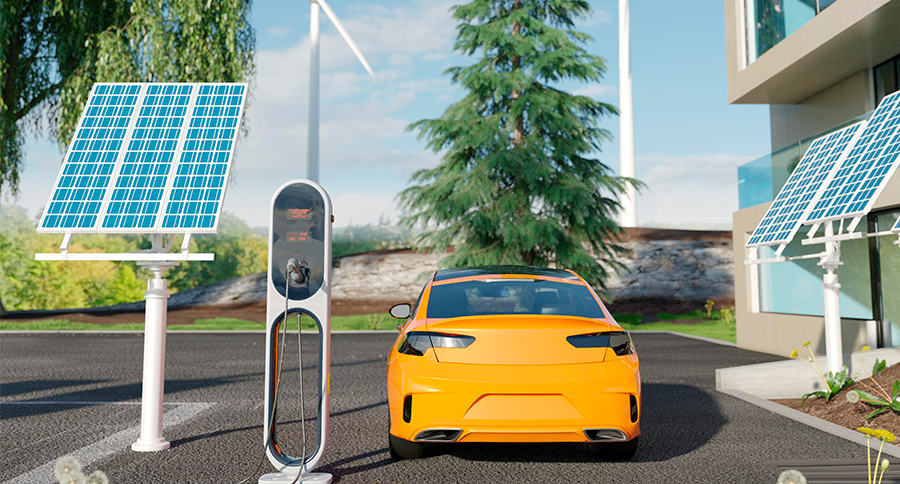
02 ส.ค. Location intelligence เพื่อยานยนต์ไฟฟ้าและวิถีชีวิตแห่งอนาคต
การเปลี่ยนยุคสู่ยานยนต์ไฟฟ้า (EV) เป็นการแก้ปัญหาวิกฤติทางสภาพอากาศที่น่าจะเกิดขึ้นเร็วกว่านี้ แม้แต่ในรัฐแคลิฟอร์เนียซึ่งมีการจดทะเบียนรถมากที่สุดในประเทศสหรัฐอเมริกา ปัจจุบันก็ได้ประกาศหยุดการขายรถยนต์ที่ใช้น้ำมันเชื้อเพลิงภายในปี ค.ศ. 2035 และบริษัทผู้ผลิตยานยนต์ต่างก็เร่งเพิ่มการผลิตรถยนต์ไฟฟ้าให้มากยิ่งขึ้น
เนื่องจากการขนส่งสร้างผลกระทบต่อการปล่อยก๊าซเรือนกระจกอย่างมาก สหรัฐจึงมีนโยบายด้านการลงทุนและการจูงใจด้วยส่วนลดหย่อน เพื่อลดการปล่อยก๊าซเรือนกระจกลงครึ่งหนึ่งภายในปี ค.ศ. 2030 ตามความตกลงปารีส (Paris Agreement) ผ่านกฎหมายต่าง ๆ เช่น กฎหมาย Infrastructure Investment and Jobs Act ที่ตั้งเป้าลงทุน 5 พันล้านบาทเพื่อขยายเครือข่ายสถานีชาร์จรถยนต์ไฟฟ้าทั่วประเทศ และกฎหมายลดอัตราเงินเฟ้อ หรือ IRA ที่ยกเลิกปริมาณการขายรถยนต์ไฟฟ้าที่ได้เครดิตภาษี ทั้งยังมีส่วนลดให้กับผู้ซื้อรถยนต์ไฟฟ้ามือสอง เป็นต้น
อย่างไรก็ดี การเปลี่ยนแปลงนี้ก็นำไปสู่ความท้าทายใหม่ เช่น ปัญหาการปล่อยก๊าซคาร์บอนในปริมาณมากจากการทำเหมืองลิเทียมเพื่อผลิตแบตเตอรี่รถยนต์ไฟฟ้าให้มากพอต่อความต้องการ ปัญหาการทำลายสิ่งแวดล้อม ปัญหาด้านการสกัดแร่ และปัญหาสิทธิมนุษยชน นอกจากนั้น โครงสร้างพื้นฐานสำหรับการชาร์จรถยนต์ไฟฟ้าในปัจจุบันก็ยังไม่มากพอ ทำให้ผู้ที่สนใจต้องชะลอการตัดสินใจซื้อจนกว่าเครือข่ายสถานีชาร์จรถยนต์ไฟฟ้าจะมีเพียงพอ ในขณะเดียวกันนักลงทุนเอกชนที่พร้อมลงทุนด้านโครงสร้างพื้นฐานของรถยนต์ไฟฟ้าก็ยังรอดูท่าทีจนกว่าปริมาณการผลิตรถยนต์ไฟฟ้าจะมากพอกับความต้องการของผู้บริโภค
ความท้าทายเหล่านี้จำเป็นต้องการข้อมูลเชิงลึกที่ไม่เพียงวิเคราะห์จุดที่ดีที่สุดสำหรับตั้งสถานีชาร์จรถยนต์ไฟฟ้า แต่ยังต้องคำนึงถึงการวางผังเมืองและโครงสร้างพื้นฐานของเมืองด้วย เพราะการเปลี่ยนยุคสู่รถยนต์ไฟฟ้าแทนการใช้เชื้อเพลิงทำให้มนุษย์เปลี่ยนวิถีการใช้ชีวิตและการเดินทาง ทั้งการลดการพึ่งพาพลังงานเชื้อเพลิงยังส่งผลให้โครงสร้างพื้นฐานของระบบขนส่งเกิดการเปลี่ยนแปลงครั้งสำคัญอีกด้วย
Location intelligence เป็นเครื่องมือสำคัญที่ทำให้เราสามารถศึกษาประเด็นที่ซับซ้อนเหล่านี้ และค้นพบโซลูชันที่เป็นไปได้
EVTown ในรัฐอิลลินอย ต้นแบบเมืองแห่งความยั่งยืน
เมืองนอร์มอล ในรัฐอิลลินอย ถือเป็นฐานสำคัญของการปฏิวัติยานยนต์ไฟฟ้า โดยเมื่อปี ค.ศ. 2011 มีการเชิญบริษัทมิตซูบิชิมาเปิดโรงงานการผลิตนวัตกรรมยานยนต์ i-MiEV ซึ่งขณะนั้นนับว่ามาเร็วกว่าความต้องการในตลาดไปมาก และภายหลังเมืองนี้จึงถูกเรียกว่า “EVTown” การเปิดโรงงานของมิตซูบิชิในเวลานั้นเกิดขึ้นพร้อมกับการวางแผนความยั่งยืนของเมือง ซึ่งมีการสร้างเส้นทางใหม่ให้จักรยานและทางเดินเท้า การจัดการปัญหาน้ำฝน การปรับปรุงสถานีรถไฟ และการลงทุนในพลังงานทดแทนและสถานีชาร์จรถยนต์ไฟฟ้า และหกปีหลังจากนั้น บริษัทรถยนต์ไฟฟ้า Rivian ซึ่งได้รับการสนับสนุนจากบริษัท Amazon ได้เข้าซื้อโรงงานเก่าของมิตซูบิชิและขยายพื้นที่เพิ่มเป็นสี่ล้านตารางฟุตเพื่อผลิตรถบรรทุก รถยนต์ SUV และรถส่งสินค้าของ Amazon โดยเหตุผลหลักที่บริษัทตัดสินใจมาทำกิจการที่เมืองนอร์มอลนี้ก็เพราะนโยบายของเมืองที่มุ่งมั่นด้านความยั่งยืนและความโปร่งใส
การที่เมืองนอร์มอลจะบรรลุตามเป้าหมายที่ตั้งไว้ได้นั้น นักวางผังเมืองจึงเลือกใช้ Location intelligence เพื่อช่วยในการตัดสินใจและติดตามความคืบหน้าของโครงการ ซึ่งแผนที่ GIS และ Dashboard ช่วยให้เจ้าหน้าที่เห็นภาพทั้งหมดของโครงการและสามารถวิเคราะห์ข้อมูลร่วมกับทีมงานและหน่วยงานต่าง ๆ ทั้งยังสามารถสื่อสารและแบ่งปันข้อมูลให้กับประชาชนได้อย่างสะดวก
นอกจากนั้น ประชาชนก็สามารถใช้แผนที่ GIS และ Dashboard แบบออนไลน์เพื่อดูแผนของโครงการและตรวจสอบการลงทุนภายในเมืองให้มีความเท่าเทียมกันได้ โดย Vasudha Gadhiraju ผู้อำนวยการสำนักงานนวัตกรรมและเทคโนโลยีของเมืองนอร์มอลมีความเห็นว่า การใช้เครื่องมือ Location intelligence นั้นมีวัตถุประสงค์เพื่อเพิ่มความสะดวกให้ประชาชนได้รับรู้ถึงสิ่งที่เกิดขึ้นภายในชุมชนด้วยข้อมูลที่ถูกต้อง
ก่อนหน้านี้ เมืองนอร์มอลเผยแพร่ข้อมูลแผนการลงทุนในชุมชนในรูปแบบ Spreadsheet ผ่านทางออนไลน์ ซึ่งเข้าใจยากและเสียเวลาในการอัพเดทข้อมูลอย่างมาก แต่ปัจจุบัน เมื่อนำเทคโนโลยี GIS มาใช้เพื่อเพิ่มความโปร่งใส ทำให้ทุกคนสามารถเข้าดูข้อมูลและศึกษาโครงการในพื้นที่ของตนได้ง่ายยิ่งขึ้น โดยเทคโนโลยี GIS ช่วยแต่ละหน่วยงานในการกรองข้อมูล บันทึกโครงการที่กำลังดำเนินการ และค้นหาตัวชี้วัดตามประเภทของโครงการได้เป็นอย่างดี
Cassidy Killian ผู้ประสานงานด้านเทคโนโลยี GIS ของเมืองนอร์มอล มีหน้าที่ควบคุมการสร้าง Dashboard ของแต่ละหน่วยงาน มีความเห็นว่าประโยชน์สูงสุดของการใช้เทคโนโลยี GIS คือการได้เห็นว่าใครทำอะไร ที่ไหน และเห็นภาพรวมทั้งหมดผ่านจอเดียว และเมื่อแต่ละหน่วยงานทำการแชร์ข้อมูลของตน ก็ช่วยให้ทีมงานมองเห็นปัญหาที่เกิดขึ้นภายในโครงการ และทำการติดตามแหล่งเงินทุนเพื่อประสานงานในแต่ละระยะของโครงการได้ เช่น ถ้าโครงการการเดินท่อประปาได้รับการอนุมัติ หน่วยงานที่ดูแลจัดการบริหารน้ำก็สามารถเห็นภาพรวมและตารางงานในการพัฒนาถนนในบริเวณพื้นที่เดียวกันได้ ทำให้ไม่ต้องขุดเจาะถนนโดยไม่จำเป็น
นักวางผังเมืองยังได้นำเทคโนโลยี GIS มาใช้ในการวางแผนและวิเคราะห์การปรับปรุงใจกลางเมืองภายใต้โครงการชื่อ Uptown Normal เปลี่ยนห้าแยกอันตรายให้กลายเป็นสวนวงเวียน Uptown Circle ซึ่งเป็นลานสาธารณะสำหรับชุมชนที่น่าเดินเล่น ส่งผลให้การจราจรมีความผ่อนคลาย จึงดึงดูดให้เกิดธุรกิจและที่อยู่อาศัยเพิ่มขึ้นภายใน Uptown Normal ทั้งยังช่วยเพิ่มมูลค่าทรัพย์สินและกระตุ้นการลงทุนใหม่ ๆ อีกด้วย
ภายในเมืองยังมีสารบัญธุรกิจที่แสดงร้านอาหาร ร้านค้า เอนเตอร์เทนเมนต์ และที่พักภายในเมือง สำหรับนักท่องเที่ยว คนในชุมชน และนักเรียน 21,000 คนในมหาวิทยาลัย Illinois State University ซึ่งสารบัญนี้ยังเป็นกระบวนการออกใบอนุญาตทางธุรกิจแบบอัตโนมัติ เพราะสามารถดึงข้อมูลสำหรับการยื่นขอใบอนุญาตจากแต่ละบริษัทผ่านออนไลน์ได้โดยตรง หากบริษัทไม่ได้อยู่ในแผนที่นั่นหมายความว่าบริษัทนั้นไม่มีใบอนุญาตในปัจจุบัน
นอกจากนั้น เมืองนอร์มอลยังได้ใช้ Location intelligence เพื่อเลือกเฟ้นโครงการที่มุ่งเน้นความยุ่งยืน และส่งเสริมการเดินทางแบบแอคทีฟ และการเดินทางต่อเนื่องหลายรูปแบบ เช่น โครงการที่ขยายเครือข่ายเส้นทางไปยังชุมชนใหม่ ๆ และโครงการที่ขยายทางจักรยานตามเส้นทางประวัติศาสตร์ Route 66 ซึ่งเชื่อมเมืองเข้ากับชุมชนอีก 5 พื้นที่ รวมทั้งโครงการ Uptown Connector Underpass ซึ่งเป็นเส้นทางใต้ทางรถไฟสำหรับคนเดินทางเท้าและจักรยานเพื่อเพิ่มการเข้าแพลตฟอร์มสถานีรถไฟ และเพิ่มความปลอดภัยสำหรับรถไฟความเร็วสูง เป็นต้น
ค้นหาศักยภาพของเทคโนโลยี GIS กับการประยุกต์ใช้ในอุตสาหกรรมอื่นๆ เพิ่มเติม
